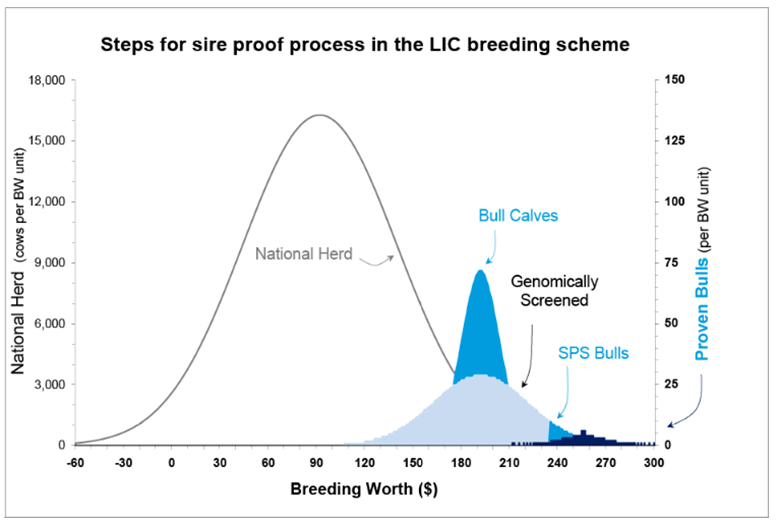LIC’s Sire Proving Scheme is a rigorous, four-year breeding programme that has been producing genetically superior bulls since 1961. Today it is one of the largest of its kind in the world.
Identifying the best of the best
Our Sire Proving Scheme produces many of New Zealand’s best bulls. Graduates from the scheme dominate the Ranking of Active Sires (RAS) List. These bulls also deliver spectacular levels of profitability in herds all over the globe.
We use a combination of ancestry records, DNA testing, and traditional daughter proving to identify the bulls that will add the most genetic value to your herd.
Of the 200 bulls in the progeny test scheme, about 20 go on to become part of our artificial insemination teams.
How LIC’s Sire Proving Scheme works
Our Sire Proving Scheme is a four year programme to find the best bulls for our national dairy herds and international markets.
Bulls that graduate from the scheme gain their proofs from the first lactation of their daughters in herds around New Zealand.
Holstein Friesian, Jersey and KiwiCross™ bulls are all included in the breeding programme. We select and rear the bulls, and we partner with top farmers in New Zealand to evaluate their breeding worth.
Choosing male calves to join the scheme
LIC works closely with our bull breeder farmers to breed bulls from elite cow families. We screen the national herd for other outstanding potential dams and receive additional offers of bulls bred from our national milking herd of 5 million cows. Each year we identify about 1700 bull calves for screening, and use genomic testing to select about 200 with the most desirable genetic traits. These important traits include:
- fertility
- fat production
- protein production
- udder support
The 200 genomically selected bull calves join the Sire Proving Scheme and spend the next four years grazing on our bull farms.
Selecting farmers to participate in the scheme
We test the daughters of bulls in the scheme in high-performing herds that are representative of the industry across geographical locations and farm systems. Top New Zealand farmers have the chance to join the scheme each year, which has about 95,000 cows producing 20,000 daughters.
Participating farms must:
- have a stable herd size between 200 – 850 cows
- sign up for four years
- mate 90% of their herd to SPS bulls
- commit to spring block calving
- record any defects
- record daughter trait comments
- have four milk recording events a year
- present the bull daughters for inspection by independent assessors
- record farmer assessed trait scores
- keep full and accurate records
Inseminating cows on participating farms
When the bull calves are a year old we collect their semen and inseminate cows in the Sire Proving Scheme herds. After birth, all the daughters are DNA parentage-verified to their sire to ensure information is allocated accurately.
Calving the daughters and measuring their performance
Daughters are mated as yearlings to calve down into herds as two year olds. Once the daughters have calved and start milking we measure their productivity through regular milk recording.
We collect other information about the daughters during their first lactation, including:
- traits other than production (management and conformation traits)
- live weight and body condition score
- calving difficulty scores for all calvings
- fertility performance measures
- culls and losses
Getting proofs for the bulls
We get proofs for the bulls using information from their daughters’ first lactation, comparing daughter performance with their contemporary group in each herd. We use the proofs to identify about 20 top-performing bulls. Their daughters consistently appear at the top end of their group across many herds. These ‘graduates’ can then join our artificial insemination teams.
But it doesn’t stop there, we continue to monitor the bulls’ performance after they have graduated from the Sire Proving Scheme to capture more data.
This is especially important for slower expressed traits such as fertility and survival, which take longer to get a full daughter proof.
The fertility trait considers the cows ability to repeatedly calve down in the first 6 weeks of calving, and is measured between lactations 1 and 5.
Survival is measured separately to fertility in the New Zealand system and, likewise, takes time to express. For these traits, the contribution of genomic estimations in our Single Step Animal Model adds improved reliability while daughter information continues to feed in.
He’s made the team!
Only about 10% of the original 200 genomically selected sires make it through to the team, and just over 1% of the original 1700 bulls calves screened. That’s some selection pressure!
Farmers can have confidence that a LIC daughter-proven bull really is the cream of the crop, with plenty of daughter evidence sitting behind him!
